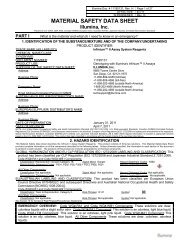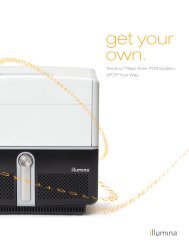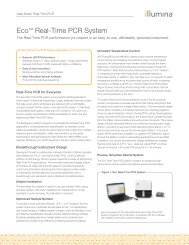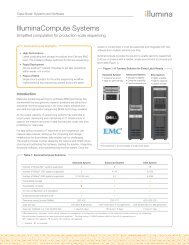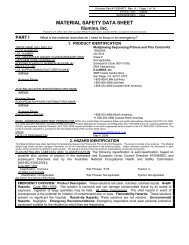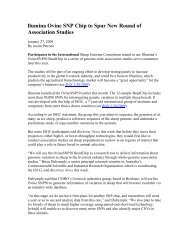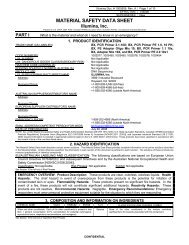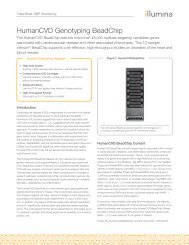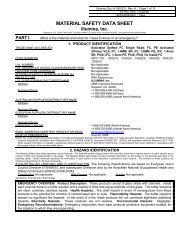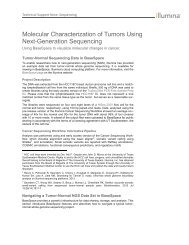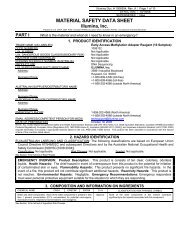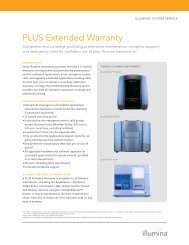MATERIAL SAFETY DATA SHEET - Illumina
MATERIAL SAFETY DATA SHEET - Illumina
MATERIAL SAFETY DATA SHEET - Illumina
You also want an ePaper? Increase the reach of your titles
YUMPU automatically turns print PDFs into web optimized ePapers that Google loves.
TruSeq Enrichment Kit <strong>Illumina</strong> Doc. #15018476, Rev. A Page 4 of 17<br />
5. FIRE-FIGHTING MEASURES (Continued)<br />
FIRE EXTINGUISHING <strong>MATERIAL</strong>S: In the event of a fire, use suppression methods for surrounding materials (e.g.,<br />
water spray, dry chemical, carbon dioxide, foam, any “ABC” class extinguisher).<br />
FIRE EXTINGUISHING <strong>MATERIAL</strong>S NOT TO BE USED: Halon extinguishers should not be used for fires involving<br />
this product.<br />
UNUSUAL FIRE AND EXPLOSION HAZARDS: GA#-HP3: This component is corrosive and presents a significant<br />
contact hazard to firefighters. When involved in a fire, this product’s components will decompose and produce<br />
irritating vapors and toxic gases (including carbon oxides, dimethyl amine, hydrogen sulfide, phosphine, cyanides,<br />
hydrogen chloride, and phosphorous, sodium and nitrogen oxides).<br />
Explosion Sensitivity to Mechanical Impact: Not sensitive.<br />
Explosion Sensitivity to Static Discharge: Not sensitive.<br />
SPECIAL FIRE-FIGHTING PROCEDURES: Do not use halogenated extinguishing media. Move containers from fire<br />
area if it can be done without risk to personnel. Incipient fire responders should wear eye protection. Structural<br />
firefighters must wear Self-Contained Breathing Apparatus and full protective equipment. Chemical resistant<br />
clothing may be necessary. If possible, prevent runoff water from entering storm drains, bodies of water, or other<br />
environmentally sensitive areas.<br />
6. ACCIDENTAL RELEASE MEASURES<br />
SPILL AND LEAK RESPONSE: Trained personnel using pre-planned procedures should respond to uncontrolled<br />
releases. Proper protective equipment should be used. In case of a spill, clear the affected area and protect people.<br />
Avoid generating airborne dusts, mists, or sprays. The atmosphere must have levels of constituents lower than<br />
those listed in Section 8, (Exposure Controls and Personal Protective Equipment), if applicable, and have at least<br />
19.5 percent oxygen before personnel can be allowed into the area without Self-Contained Breathing Apparatus<br />
(SCBA).<br />
Small Spills: Lightweight gloves, a lab coat, and eye protection should be worn. Absorb spilled liquid with paper towels. Wipe up spilled<br />
solid using non-combustible material. Wash contaminated area with soap and water, absorb with paper towels, and rinse with water.<br />
Large Spills: Minimum Personal Protective Equipment should be Level C: triple-gloves (rubber gloves and nitrile gloves over latex<br />
gloves), chemical resistant suit and boots, hard hat, and Air-Purifying respirator with organic vapor cartridge. Self-Contained<br />
Breathing Apparatus must be selected if release occurs in confined or poorly ventilated areas or in situations in which the<br />
level of oxygen is below 19.5%. Absorb spilled liquid with polypads or other suitable absorbent materials. Dike or otherwise contain<br />
spill and remove with vacuum truck or pump to storage/salvage vessels. Decontaminate the area thoroughly. Prevent material from<br />
entering sewer or confined spaces, waterways, soil or public waters. Monitor area and confirm levels are bellow exposure limits given<br />
in Section 8 (Exposure Controls-Personal Protection), if applicable, before non-response personnel are allowed into the spill area.<br />
Place all spill residue in a double plastic bag or other containment and seal. Decontaminate the area thoroughly.<br />
Do not mix with wastes from other materials. Dispose of in accordance with applicable Federal, State, and local<br />
procedures (see Section 13, Disposal Considerations). For spills on water, contain, minimize dispersion and collect.<br />
Dispose of recovered material and report spill per regulatory requirements.<br />
PART III How can I prevent hazardous situations from occurring?<br />
7. HANDLING and STORAGE<br />
SAFE WORK AND HYGIENE PRACTICES: As with all chemicals, avoid getting this product’s components ON YOU<br />
or IN YOU. Wash thoroughly after handling this product’s components. Avoid splashing or spraying this product’s<br />
components. Do not eat or drink while handling this product’s components.<br />
STORAGE AND HANDLING PRACTICES: All employees who handle this material should be trained to handle it<br />
safely. Avoid breathing vapors, mists, or sprays generated by this product’s components. Ensure containers of this<br />
product’s components are properly labeled. Open containers slowly on a stable surface. Store vials as directed in<br />
the product insert. Store away from incompatible materials. Material should be stored in secondary containers, as<br />
appropriate. Storage areas should be made of fire resistant materials. Post warning and “NO SMOKING” signs in<br />
storage and use areas, as appropriate. Have appropriate extinguishing equipment in the storage area (i.e., sprinkler<br />
system, portable fire extinguishers). Keep vials tightly closed when not in use. Inspect vials containing this<br />
product’s components for leaks or damage. Read instructions provided with the product prior to use.<br />
SPECIFIC USE(S): This product is for use in laboratory biological research. Follow all industry standards for use.<br />
PROTECTIVE PRACTICES DURING MAINTENANCE OF CONTAMINATED EQUIPMENT: Follow practices<br />
indicated in Section 6 (Accidental Release Measures). Make certain that application equipment is locked and<br />
tagged-out safely, as applicable. Collect all rinsates and dispose of according to applicable Federal, State, and local<br />
procedures standards.<br />
8. EXPOSURE CONTROLS - PERSONAL PROTECTION<br />
VENTILATION, ENGINEERING, AND OCCUPATIONAL EXPOSURE CONTROLS: Use with adequate ventilation to<br />
ensure exposure levels are maintained below the limits provided below, if applicable. If necessary, refer to<br />
Australian National Code of Practice for the Control of Workplace Hazardous Substances [NOHSC: 2007 (1994)]<br />
for further information. As with all products that contain chemicals, ensure proper decontamination equipment (e.g.,<br />
eyewash/safety shower stations) are available near areas where this product is used as necessary.



